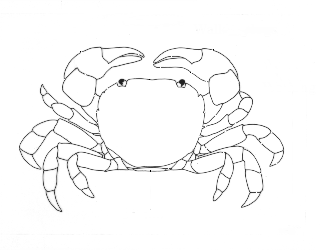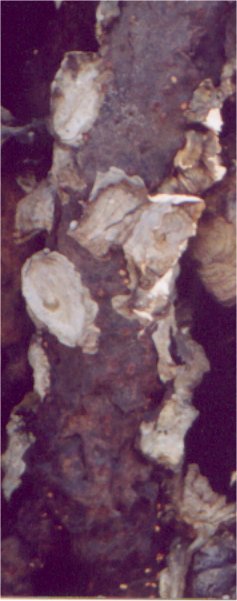
|
A field guide to Kenyan
mangroves
|
|
Saccostrea cucullata (Born, 1778)
Family: Ostreidae
|
Zone: Lower intertidal areas.
Habitat: On trunks and roots of mangroves and rocky substrate (Tack et al., 1992).
Food: Filter feeder (Tack and Polk, 1996).
Ecological notes: This edible oyster is common in Kenyan mangroves and can even be seen growing on T. palustris (Tack et al., 1992; Gillikin, 2000). Adult oysters can chemically signal settlement of spat (Tack and Polk, 1995a).
Distinguishing characteristics: Growth form highly variable, but it is the only oyster in Kenyan mangroves (Okemwa et al., 1986; Tack et al., 1992).
Geographical range: Seychelles, Aldabra, Tanzania, Somalia and Kenya (Tack et al., 1992). |
 |

References:
Gillikin, D.P., 2000. Factors controlling the distribution of Kenyan brachyuran mangrove crabs: Salinity tolerance and ecophysiology of two Kenyan Neosarmatium species. M.Sc. Thesis, Free University of Brussels, Brussels, Belgium.
Okemwa, E.R., R.K. Ruwa and P. Polk, 1986. The autecology of the edible oyster Crassostrea cucullata Born, 1778: size-related vertical distribution at Mkomani, Mombasa. Kanyan Journal of Science Series B 30: 409-434.
Tack J.F., Vanden Berghe, E., Polk, Ph. 1992. Ecomorphology of Saccostrea cucullata (Born, 1778) (Ostreidae) in a mangrove creek (Gazi, Kenya). Hydrobiologia 247: 109-117.
Tack, J.F. and P. Polk, 1995a. Communication between adult oysters and larvae of Saccostrea cucullata. In: P. Lavens, E. Jaspers and I. Roelants (eds.), Fish & shellfish larviculture. European Aquaculture Society Special Publication 24: 65-68.
Tack, J.F. and P. Polk, 1995b. Modification of the settling behaviour of Saccostrea cucullata (von Born, 1778) leads to a change in food uptake. In: N. Svennevig and A. Krogdahl (eds.), Quality in Aquaculture. European Aquaculture Society Special Publication 23: 237-238.
Tack, J.F. and P. Polk, 1996. The Uptake of Colloidal Melanin from Seawater by Marine Bivalves. Marine Ecology 17(1-3): 543-548.